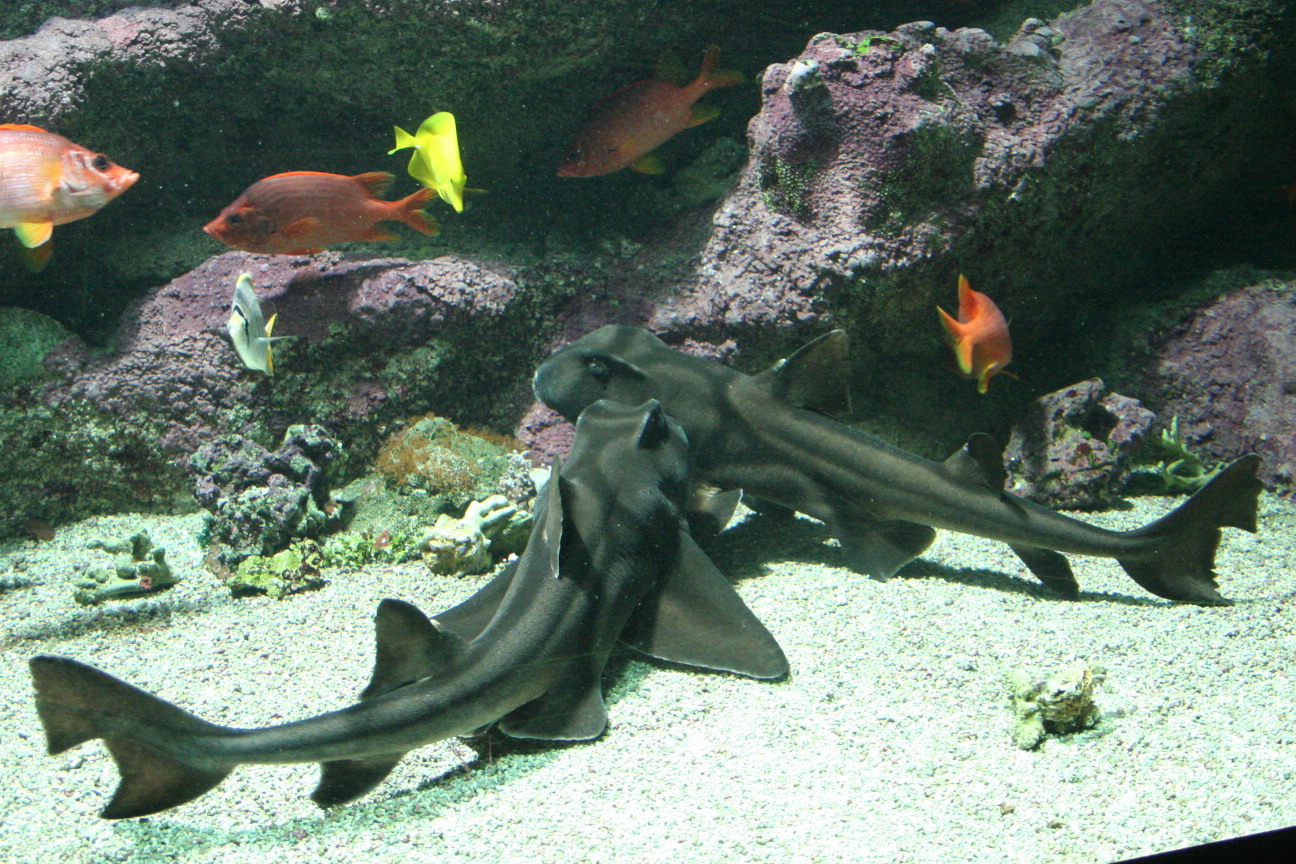- Bullhead sharks
Taxobox
name = Bullhead sharks
fossil_range = Fossil range|174|0 LateToarcian to Present [cite journal
last = Sepkoski
first = Jack
authorlink =
coauthors =
title = A compendium of fossil marine animal genera (Chondrichthyes entry)
journal = Bulletins of American Paleontology
volume = 364
issue =
pages = p.560
publisher =
location =
date = 2002
url = http://strata.ummp.lsa.umich.edu/jack/showgenera.php?taxon=575&rank=class
doi =
id =
accessdate = 2008-01-09 ]

image_width = 210px
image_caption = TwoPort Jackson shark s ("Heterodontus portusjacksoni")
regnum =Animal ia
phylum = Chordata
classis =Chondrichthyes
subclassis =Elasmobranchii
superordo =Selachimorpha
ordo = Heterodontiformes
ordo_authority = Berg, 1940
familia = Heterodontidae
familia_authority = Gray, 1851
genus = "Heterodontus"
genus_authority = Blainville, 1816
subdivision_ranks = Species
subdivision = See text.The bullhead sharks are a small order (Heterodontiformes) of very basal (primitive) modernshark s (Neoselachii ). There are nine living species in a single genus, "Heterodontus", in the family Heterodontidae. All are relatively small (50 to 150 cm)(20 to 59 inches) bottom feeders in tropical and subtropical waters.The Heterodontiforms are morphologically rather distinctive. The mouth is located entirely
anterior to the orbits. Labial cartilages are found in the most anterior part of the mouth. Nasoral grooves are present, connecting the external nares to the mouth. The nasal capsules are "trumpet-shaped" & well-separated from orbits. Circumnarialskin fold s present; but the rostral process ofneurocranium (braincase) absent, although aprecerebral fossa is present. Finally, the braincase bears asupraorbital crest .The eyes lack a
nictitating membrane . Aspiracle is present, but small. The dorsal ends of branchial arches 4 and 5 are attached, but not fused into a "pickaxe" as in lamniform sharks. Heterodontiforms have 2dorsal fin s, with fin spines, as well as ananal fin . The dorsal and anal fin also contain basalcartilage s, not just fin rays.The Heterodontiforms appear in the fossil record in the Early
Jurassic , well before any of the otherGaleomorphii , a group which includes all modern sharks except thedogfish and its relatives. However, they have never been common, and it is likely their origin lies even further back.Species
*
Horn shark , "Heterodontus francisci " (Girard, 1855) [http://www.fishbase.org/Summary/SpeciesSummary.cfm?ID=739&genusname=Heterodontus&speciesname=francisci]
*Crested bullhead shark , "Heterodontus galeatus " (Günther, 1870) [http://www.fishbase.org/Summary/SpeciesSummary.cfm?ID=740&genusname=Heterodontus&speciesname=galeatus]
*Japanese bullhead shark , "Heterodontus japonicus " Maclay & Macleay, 1884 [http://www.fishbase.org/Summary/SpeciesSummary.cfm?ID=741&genusname=Heterodontus&speciesname=japonicus]
*Mexican hornshark , "Heterodontus mexicanus " Taylor & Castro-Aguirre, 1972 [http://www.fishbase.org/Summary/SpeciesSummary.cfm?ID=742&genusname=Heterodontus&speciesname=mexicanus]
*Oman bullhead shark , "Heterodontus omanensis " Baldwin, 2005
*Port Jackson shark , "Heterodontus portusjacksoni " (Meyer, 1793) [http://www.fishbase.org/Summary/SpeciesSummary.cfm?ID=743&genusname=Heterodontus&speciesname=portusjacksoni]
*Galapagos bullhead shark , "Heterodontus quoyi " (Fréminville, 1840) [http://www.fishbase.org/Summary/SpeciesSummary.cfm?ID=744&genusname=Heterodontus&speciesname=quoyi]
*Whitespotted bullhead shark , "Heterodontus ramalheira " (Smith, 1949) [http://www.fishbase.org/Summary/SpeciesSummary.cfm?ID=745&genusname=Heterodontus&speciesname=ramalheira]
*Zebra bullhead shark , "Heterodontus zebra " (Gray, 1831) [http://www.fishbase.org/Summary/SpeciesSummary.cfm?ID=746&genusname=Heterodontus&speciesname=zebra]References
*
*
Wikimedia Foundation. 2010.
